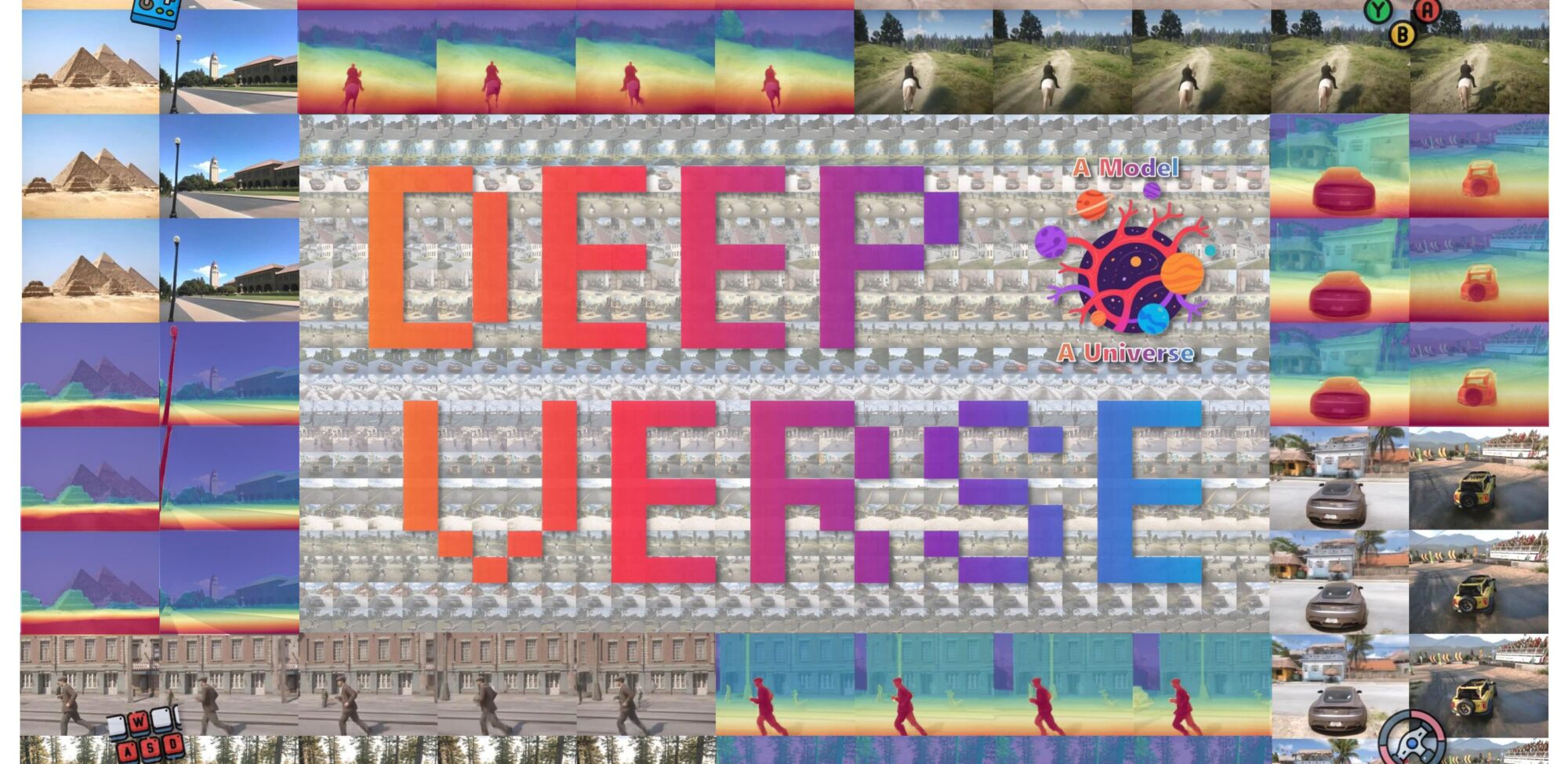
🎮🌌 🎮🌌 DeepVerse: Crafting Infinite Game Worlds with 4D Autoregressive Video Generation (Generate game from the game scene)

🧠 Conceptualization and Design
The inception of DeepVerse stemmed from the need to bridge the gap between static game environments and dynamic, interactive worlds. Traditional game development often relies on predefined scripts and assets, limiting the adaptability and immersion of the gaming experience. To address this, we envisioned a system capable of generating game worlds that evolve in response to player interactions, offering a more organic and engaging experience.
The core idea was to develop a model that not only predicts visual sequences but also understands and generates the underlying geometry of the game world. This approach would enable the creation of expansive, coherent, and interactive environments that can adapt in real-time to player actions.
imagine a game that evolves in real-time, adapting to your every move and creating a unique experience each time you play. This is the promise of DeepVerse, an innovative AI model that generates dynamic game worlds by predicting future frames based on past interactions.
🧠 What Is DeepVerse?
DeepVerse is a cutting-edge AI model that utilizes 4D autoregressive video generation to simulate and predict game environments. By understanding both the visual and spatial aspects of a game, DeepVerse can create immersive worlds that respond intelligently to player actions.
🔍 How Does It Work?
At its core, DeepVerse analyzes sequences of game frames to learn patterns and structures. It then uses this knowledge to generate future frames, ensuring continuity and coherence in the game world. This approach allows for the creation of expansive, interactive environments that feel alive and reactive.
🎮 Why Does It Matter?
Traditional game development often involves manually designing each element of a game world. DeepVerse revolutionizes this process by automating world generation, enabling developers to create vast, dynamic environments with ease. This not only saves time but also opens up new possibilities for gameplay and storytelling.
🧠 Comparative Overview: DeepVerse vs. AR4D vs. Genie 2
| Feature | DeepVerse | AR4D | Genie 2 |
|---|---|---|---|
| Model Type | 4D Autoregressive Video Generation as a World Model | Autoregressive 4D Generation from Monocular Videos | Autoregressive Latent Diffusion Model |
| Primary Focus | Interactive world modeling with explicit geometric predictions | 4D generation from monocular videos without relying on Score Distillation Sampling (SDS) | Generating interactive 3D environments from single prompt images |
| Input Type | Sequences of game frames | Monocular videos | Single images or text descriptions |
| Geometric Awareness | Incorporates explicit geometric constraints to capture spatio-temporal relationships and physical dynamics | Utilizes pre-trained expert models to create 3D representations of frames | Employs a video tokenizer and latent action model to understand and generate 3D environments |
| Temporal Consistency | Maintains long-term spatial consistency through geometry-aware memory retrieval | Achieves improved spatial-temporal consistency by generating each frame’s 3D representation based on its previous frame’s representation | Features long-horizon memory, maintaining consistency in world generation and accurately remembering previously observed areas |
| Control Mechanism | Generates future frames conditioned on actions, enabling interactive world modeling | Incorporates a refinement stage based on a global deformation field to prevent appearance drift during autoregressive generation | Allows intelligent response to user inputs, interpreting and executing player actions in generated environments |
| Use Cases | Ideal for creating dynamic, interactive game worlds that evolve in response to player interactions | Suitable for generating novel-view videos and reconstructing 3D scenes from monocular videos without relying on SDS | Enables the creation of diverse 3D environments for AI training, game development, and virtual reality applications |
| Strengths | High-fidelity, long-horizon predictions<br>- Geometry-aware dynamics<br>- Enhanced prediction accuracy and visual realism | SDS-free 4D generation<br>- Improved diversity and spatial-temporal consistency<br>- Better alignment with input prompts | Real-time interactive environments<br>- Long-horizon memory<br>- Rapid prototyping from concept art |
| Limitations | Primarily focused on game world modeling<br>- May require substantial computational resources | Limited to monocular video inputs<br>- May not capture complex interactions as effectively as other models | Generates consistent worlds for up to a minute<br>- May not maintain long-term consistency beyond that timefram |
DeepVerse stands out by explicitly incorporating geometric constraints into its autoregressive framework, enhancing spatial coherence and reducing drift over extended sequences. This makes it particularly suitable for generating interactive game worlds that respond intelligently to player actions.
AR4D focuses on 4D generation from monocular videos without relying on Score Distillation Sampling (SDS), achieving improved spatial-temporal consistency and better alignment with input prompts. Its approach is ideal for generating novel-view videos and reconstructing 3D scenes from monocular videos.
Genie 2, developed by Google DeepMind, is an autoregressive latent diffusion model trained on large video datasets. It can generate interactive 3D environments from single prompt images, featuring long-horizon memory and intelligent response to user inputs. This makes it suitable for creating diverse 3D environments for AI training, game development, and virtual reality applications.
Each model offers unique capabilities tailored to specific applications in the realm of 4D video generation and world modeling.
🛠️ DeepVerse Setup Guide
🔧 Minimum Hardware Specifications
| Component | Minimum Requirement |
|---|---|
| GPU | NVIDIA RTX 3060 (12 GB VRAM) or equivalent |
| CPU | AMD Ryzen 5 / Intel i7 (or higher) |
| RAM | 32 GB DDR4 |
| Storage | SSD with at least 500 GB free space |
| Operating System | Linux (Ubuntu 20.04 or later) |
| CUDA Version | CUDA 12.4 or compatible |
Note: For optimal performance, especially during training or generating high-resolution videos, a GPU with 24 GB VRAM (e.g., RTX 3090 or A100) is recommended
🖥️ Software Requirements
- Python: 3.11 or higher
- PyTorch: 2.4.0 with CUDA 12.4 support
- Dependencies:
torchvisiontorchaudioninjaflash-attentiongit-lfs(for large model weights)bitsandbytes(for quantization)
- Optional:
- Docker (for containerized setup)
ffmpeg(for video encoding/decoding)digialps.com+1github.com+1github.com
⚙️ Setup Instructions
- Clone the Repository: bashCopyEdit
git clone https://github.com/SOTAMak1r/DeepVerse cd DeepVerse
- Create and Activate a Python Environment: bashCopyEdit
python -m venv deepverse-env source deepverse-env/bin/activate
- Install Dependencies: bashCopyEdit
pip install -r requirements.txt
- Install Flash Attention: bashCopyEdit
pip install git+https://github.com/Dao-AILab/flash-attention.git@v2.6.3
- Set Up CUDA:
Ensure that CUDA 12.4 is installed and properly configured on your system. Refer to the official NVIDIA CUDA installation guide for detailed instructions. - Download Pre-trained Weights: bashCopyEdit
git lfs install git lfs pull
- Run DeepVerse: bashCopyEdit
python generate.py --input "path_to_input_video.mp4" --output "output_video.mp4"
🚀 Performance Tips
- Resolution: Start with lower resolutions (e.g., 720p) to test the setup before scaling up.
- Batch Size: Adjust the batch size based on your GPU’s VRAM capacity.
- Precision: Utilize mixed precision (e.g.,
float16) to reduce memory usage. - Offloading: Consider offloading computations to CPU if GPU memory is limited
Conclusion: represents a significant leap forward in the realm of interactive world modeling, addressing key limitations of existing models by integrating explicit geometric predictions into its autoregressive framework. This innovative approach enables the generation of dynamic, coherent, and interactive game worlds that evolve in response to player actions, offering a more immersive and engaging experience.
Key Contributions:
- Geometric Awareness: By incorporating geometric constraints from previous timesteps, DeepVerse captures richer spatio-temporal relationships and underlying physical dynamics. This capability significantly reduces drift and enhances temporal consistency, enabling the model to reliably generate extended future sequences with high fidelity.
- Action-Conditioned Generation: DeepVerse generates future frames conditioned on actions, allowing for interactive world modeling. This feature enables the creation of game worlds that respond intelligently to player inputs, enhancing interactivity and immersion.
- Geometry-Aware Memory Retrieval: The model’s ability to retrieve and utilize geometric information from previous frames ensures long-term spatial consistency, effectively preserving the integrity of the generated world over extended sequences.
Comparative Advantage:
When compared to other world modeling efforts, such as AR4D and Genie 2, DeepVerse offers several distinct advantages:
- Geometry-Aware Modeling: While AR4D focuses on monocular video reconstruction, DeepVerse explicitly incorporates geometric structures, leading to more accurate and consistent world generation.
- Extended Sequence Generation: DeepVerse’s autoregressive framework allows for the generation of longer and more coherent sequences, a challenge for many existing models.
- Interactive World Simulation: Unlike passive video generation models, DeepVerse can simulate interactive game worlds, paving the way for real-time game development.
Future Directions:
The integration of DeepVerse into game development pipelines holds the potential to revolutionize the industry. Future advancements may include:
- Real-Time World Generation: Enabling the creation of expansive game worlds on-the-fly, reducing development time and costs.
- Enhanced Interactivity: Allowing for more responsive and adaptive game environments that evolve based on player behavior.
- Cross-Platform Integration: Facilitating the deployment of generated worlds across various gaming platforms, ensuring a consistent experience for all players.
📘 Core Paper
- DeepVerse: 4D Autoregressive Video Generation as a World Model
Chen, J., Zhu, H., He, X., Wang, Y., Zhou, J., Chang, W., Zhou, Y., Li, Z., Fu, Z., Pang, J., & He, T. (2025). arXiv:2506.01103.
This paper introduces DeepVerse, a novel 4D interactive world model that incorporates geometric predictions from previous timesteps into current predictions conditioned on actions. The model captures richer spatio-temporal relationships and underlying physical dynamics, significantly reducing drift and enhancing temporal consistency. arxiv.org+1tonghe90.github.io+1
🔍 Comparative and Related Works
- AR4D: Autoregressive 4D Generation from Monocular Videos
Zhu, H., He, T., Yu, X., Guo, J., Chen, Z., & Bian, J. (2025). arXiv:2501.01722.
AR4D presents a novel paradigm for SDS-free 4D generation, utilizing pre-trained expert models to create 3D representations and generating each frame’s 3D representation based on its previous frame’s representation. arxiv.org+1hanxinzhu-lab.github.io+1 - DiCoDe: Diffusion-Compressed Deep Tokens for Autoregressive Video Generation with Language Models
Li, Y., Ge, Y., Ge, Y., Luo, P., & Shan, Y. (2024). arXiv:2412.04446.
DiCoDe leverages Diffusion-Compressed Deep Tokens to generate videos with a language model in an autoregressive manner, achieving significant compression and enabling scalable video modeling. arxiv.org+1liyizhuo.com+1 - 4Real: Towards Photorealistic 4D Scene Generation via Video Diffusion Models
Yu, H., Wang, C., Zhuang, P., Menapace, W., Siarohin, A., Cao, J., Jeni, L. A., Tulyakov, S., & Lee, H.-Y. (2024). arXiv:2406.07472.
4Real introduces a pipeline for photorealistic text-to-4D scene generation, utilizing video generative models trained on diverse real-world datasets to enhance scene realism and structural integrity. arxiv.org - Cosmos-1.0-Autoregressive-13B-Video2World | NVIDIA NGC
NVIDIA (2025).
Cosmos-1.0-Autoregressive-13B-Video2World is an autoregressive transformer model designed for world generation, capable of generating physics-aware videos and world states from video or image inputs. desaixie.github.io+14catalog.ngc.nvidia.com+14arxiv.org+14
🧠 Foundational Concepts and Techniques
- HARP: Autoregressive Latent Video Prediction with High-Fidelity Image Generator
Seo, Y., Lee, K., Liu, F., James, S., & Abbeel, P. (2022). arXiv:2209.07143.
HARP investigates training an autoregressive latent video prediction model capable of predicting high-fidelity future frames with minimal modification to existing models, enabling high-resolution video prediction. arxiv.org - Pre-Trained Video Generative Models as World Simulators
He, H. (2025). arXiv:2502.07825.
This work explores the use of pre-trained video generative models as world simulators, introducing a motion-reinforced loss to enhance action controllability and demonstrating improvements in generating action-controllable, dynamically consistent videos. - Autoregressive Video Models – Microsoft Research: Diagonal-decoding
Microsoft Research (2025).
Diagonal Decoding (DiagD) is a training-free inference acceleration algorithm for autoregressively pre-trained models that exploits spatial and temporal correlations in videos, achieving up to 10x speedup compared to naive sequential decoding.
